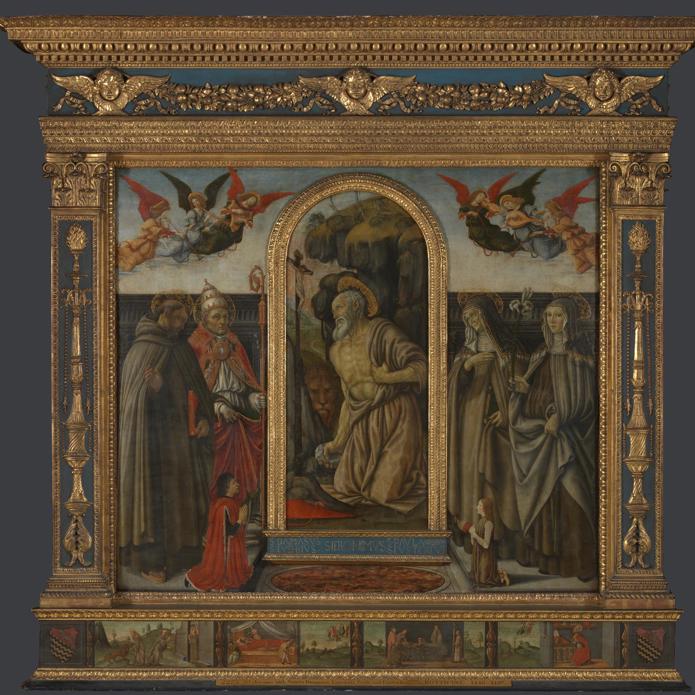Francesco Botticini, 'Saint Jerome in Penitence with Saints and Donors', about 1490
About the work
Overview
This is the main panel of the S. Gerolamo Altarpiece, one of the most important works of the Florentine painter Francesco Botticini. It is named after Saint Jerome (Gerolamo or Girolamo in Italian), the figure prominently depicted at its centre, and the church dedicated to him where it originally stood.
Saint Jerome was a celebrated fourth-century theologian. He is shown here clutching the stone that, according to his legend, he pounded against his chest to help him resist temptation. During the fifteenth century, a cult dedicated to the saint found many followers, leading to the establishment of numerous religious houses across the Italian Peninsula. The church of S. Gerolamo in Fiesole, a small town in the hills above Florence, was the regional centre of the Hieronymites.
The patron of the altarpiece, the Florentine patrician Girolamo di Piero di Cardinale Rucellai, kneels to the left of the framed image of Saint Jerome, opposite his son.
Key facts
Details
- Full title
- Saint Jerome in Penitence with Saints and Donors
- Artist
- Francesco Botticini
- Artist dates
- about 1446 - 1497
- Part of the group
- S. Gerolamo Altarpiece
- Date made
- about 1490
- Medium and support
- egg tempera on wood
- Dimensions
- 235 × 258 cm
- Acquisition credit
- Bought, 1855
- Inventory number
- NG227.1
- Location
- Not on display
- Collection
- Main Collection
Provenance
Additional information
Text extracted from the ‘Provenance’ section of the catalogue entry in Martin Davies, ‘National Gallery Catalogues: The Earlier Italian Schools’, London 1986; for further information, see the full catalogue entry.
Exhibition history
-
2011Devotion by Design: Italian Altarpieces before 1500The National Gallery (London)6 July 2011 - 2 October 2011
Bibliography
-
1897A. Schmarsow et al., Festschrift zu ehren des Kunsthistorischen Instituts in Florenz, Leipzig 1897
-
1951Davies, Martin, National Gallery Catalogues: The Earlier Italian Schools, London 1951
-
1986Davies, Martin, National Gallery Catalogues: The Earlier Italian Schools, revised edn, London 1986
-
2001
C. Baker and T. Henry, The National Gallery: Complete Illustrated Catalogue, London 2001
About this record
If you know more about this painting or have spotted an error, please contact us. Please note that exhibition histories are listed from 2009 onwards. Bibliographies may not be complete; more comprehensive information is available in the National Gallery Library.
Images
About the group: S. Gerolamo Altarpiece

Overview
The S. Gerolamo Altarpiece, named after the saint prominently depicted at its centre and the church where it originally stood, is among the most important works of the Florentine painter Francesco Botticini. The artist was an exact contemporary of Sandro Botticelli, with whom he may have trained in the workshop of Andrea del Verrocchio.
The fourth-century theologian Saint Jerome (Gerolamo or Girolamo in Italian) is best known for his translation of the Bible from the original Hebrew and Greek into Latin. During the fifteenth century a cult dedicated to the saint found many followers (called Hieronymites), leading to the establishment of numerous religious houses across the Italian peninsula. This altarpiece comes from their church in Fiesole, a small town in the hills above Florence. Its patron, the Florentine patrician Girolamo di Piero di Cardinale Rucellai, can be seen kneeling to the left of the framed image of Saint Jerome, opposite his son.




